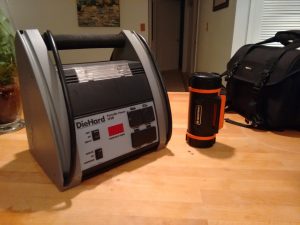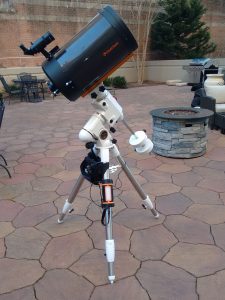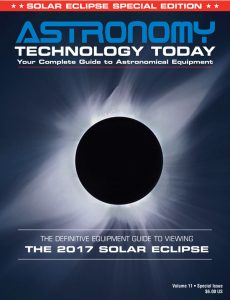The evolution of the lead-acid and lithium-ion battery finally adds convenience to the revolution of affordable go-to mounts.
By George Stallings
The leaps between the technology of today versus that when I received an un-motorized equatorial 114-mm Newtonian reflector as a 10-year-old in 1988, are mind boggling. I would have barely recognized today’s average reflectors, with red-dot finders, go-to drives, things that plug and unplug, and that use something called GPS to know where and when they are.

However, until recently, what I (as well as my great-grandparents) would have recognized immediately is the nearly anachronistic power source of these technological marvels: lead-acid batteries. The irony is, old-technology batteries power many of today’s lightweight, advanced go-to mounts. These batteries often weigh nearly as much as the mounts to which they provide power.
For years, I have been using a very reliable, relatively powerful, 12-volt, 22-Ah Sears DieHard 1150 (Image 1) sealed lead-acid battery. As was the case with consumer batteries until recently, with great power comes great weight. My trusty old power source weighs in at a hefty 22 pounds (10 kilograms). In comparison, my grab-and-go setup, which consists of iEQ30 Pro mount with a 10-pound counterweight, lightweight tripod, and Celestron C8 optical tube assembly, weighs less than 50 pounds (22.7 kilograms) … without a battery.
After carting this setup, plus its 22-pound battery, around to my local observing sites for a couple years, I decided I needed a less-weighty alternative that could put some more “go” into my almost “grab and go” telescope. Also, I was looking for a battery that could provide power to my heavier Sky-Watcher EQ6, as well, which is why I decided to buy Celestron’s new Lithium PowerTank.
What Is It?
Celestron’s Lithium PowerTank is an 84.4-watt hour (7-amp hour at 12-volts), new class of rechargeable 12-volt battery that employs lithium iron phosphate (LiFePO4) as its cathode material. In comparison to lead-acid or other lithium-based rechargeable battery chemistries, lithium iron phosphate batteries provide increased charge/discharge cycles (up to 2,000 recharges) and faster recharge rates.
They are intrinsically safer than lead acid or other lithium-based battery chemistries, so they are less likely to catch fire with proper usage, cannot leak acid and are chemically stable and non-toxic. They also have significantly improved energy densities over lead-acid batteries (Wh/kg), thus weighing much less per watt of power provided than lead-acid battery types. Unlike other lithium ion batteries, they have a nearly constant discharge voltage, an important characteristic for mounts that are sensitive to voltage input, such as my mounts are.
Another important aspect of LiFePO4 batteries is that they have a greater depth of discharge, without incurring damage, than lead acid batteries have. Generally, while lead-acid rechargeable batteries can provide up to 50 percent of their rated capacity before causing permanent damage, LiFePO4 batteries can provide up to 90 percent of their rated capacity without incurring damage. This means that, in theory, I can expect the 2.25-pound Celestron Lithium PowerTank to provide at least half the watt-hours of power as my 22-pound DieHard lead-acid under equal conditions and precautions.
What Is Included
The body of Celestron Lithium PowerTank contains an adjustable-brightness red light, as well as a white-light “illumination panel,” along with two 5-volt USB charging ports with current outputs of 2.1 amps and 1.0 amp, and one charging/12-volt DC output port. The battery comes supplied with a Velcro strap to attach to tripod legs, as well as strap with clips to allow users to hang it from any place on the mount or other anchor point (Image 2). It also includes a dedicated charger that converts an input of 110- to 240-volt to the 16-volt DC at which the PowerTank is charged. This charger is supplied with input plug adapters that will work in mains electrical outlets worldwide, befitting its portability. An included 2.1-mm x 5.5-mm DC plug supplies power to the mount.
How It Works
The battery is intuitive to use. Pressing the power button (Image 3) once charges connected USB devices. Similarly, pressing the power button once provides power to the mount, when the mount is connected. The power button will also illuminate the power indicator lights, displaying the remaining charge left in the battery. Four illuminated lights mean the charge is full, while three, two, and one illuminated light(s) indicate a 75-percent, 50-percent, and 25-percent remaining charge respectively.
Pressing the lighting control button once turns on the LED red-light illumination panel, while pressing this button a second time increases that light’s brightness. Pressing the lighting control button a third time will turn the light off. Pressing the lighting control button for two seconds activates the white light. As with the red light, once the white light is turned on, pressing the light button a second time will increase the white light’s brightness, and pressing it a third time will turn the white light off. It is possible to use the lights while the battery is providing power to the mount. However, in my unit, it was not possible to charge USB devices while providing power to the mount.
Performance
Celestron advertises that the Lithium PowerTank provides up to ten hours of telescope runtime, a figure that is not overly optimistic with my equipment in both ideal conditions and in real world use. Indoor slewing and tracking testing revealed a runtime of a little more than 8.5 hours using a well-balanced Celestron C11 mounted on a Sky-Watcher EQ6. This runtime was not to the point of failure of the battery, but it was to the point at which the mount began to show some of its telltale signs of low-voltage operation (e.g. flashing power light).
While the runtime was not quite the advertised 10 hours, the Lithium PowerTank’s runtime exceeded by a factor of nearly two that of a 6.0-Ah (72Wh) lithium cobalt oxide-based rechargeable battery I purchased previously. Possibly, this is due to the steadier voltage output of LiFePO4 batteries.
The battery’s performance is better than I expected for a mount with an estimated power consumption of up to 2.0 amps (24 watts) while slewing and up to 1.0 amp (12 watts) while tracking under load. As these power consumption figures for my iOptron iEQ30 Pro are 0.6A (7.2 watts) and 0.4A (4.8 watts) respectively, I expect the Lithium PowerTank’s performance to at least meet, and possibly exceed, Celestron’s advertised runtime when paired with that mount.
During several observing sessions at temperatures near or below freezing with the EQ6 and the Lithium PowerTank, I have never consumed more than 50 percent of the available power from full charge, as indicated by the charge indicator lights. These sessions averaged about 3.5 hours each. Battery charge time from near flat to full is less than four hours.
The form factor of this battery points to its design by an astronomy-equipment manufacturer specifically for amateur astronomers. For example, the shape of the battery casing allows it to lie flat or hug rounded tripod legs. This ability to affix the battery to a tripod reduces its tendency to act as a trip hazard in the dark. Further evidence of design intent are covers for the power jacks and USB ports to keep dew from finding its way into the battery’s internal compartment. Similarly, the default LED illumination choice is the red, which makes it more difficult to activate the dark vision-ruining white light accidently – a nice touch.
The Revolution No Longer Weighs a Ton
While not as revolutionary as the advent of affordable go-to mounts, the technology this battery employs makes go-to mounts much more convenient to use in terms of weight. My iOptron iEQ30 Pro and Celestron C8 combination is now much more portable and convenient. This tends to happen when a battery that weighs nearly half as much as the rest of the setup is no longer necessary. Another way to consider it is this: When I decide to take the Lithium PowerTank with me, as opposed to the DieHard 1150, I subtract a weight equal to that of a Celestron C9.25 from that evening’s observing gear.

In practical use, the PowerTank weighs so little that twice I have forgotten that I had already packed it as I headed out for observing sessions. While it does not turn my EQ6 paired with a Celestron C11 (Image 5) into a grab-and-go, ultra-portable setup, it makes for two fewer trips to the car. With hands numb from the cold at 3:00 a.m., even one less trip does not go unappreciated.
The LiFePO4 is a dedicated power source for my mount. While it can also charge peripherals via USB ports, it is not a complete replacement of the large lead-acid batteries for everyone or all situations. But that is not the design intent of the product. While 84.4 watts of power is perfect for an evening’s visual observing sessions, enthusiasts who require heated dew control most nights, and who need power for laptops, CCD cameras, cooling fans and other accessories, will find they still need their large batteries.
This is a battery for people who just want to observe or who want to power their mounts separately from other equipment. For these purposes, it is a perfect weight and capacity for grab-and-go and high-capacity mounts alike. While I still need that 22-pound DieHard 1150 on occasion, most nights, I can now go out without it.
George Stallings has been observing for more than 25 years, though he has only recently jumped into the world of lunar and planetary imaging. A career information analyst and .lifelong science-hobbies enthusiast, he navigates the fine line between late nights imaging and early mornings consulting for the federal government in northern .
###
 The Astronomy Technology Today editorial staff would like to take this opportunity to remind you of the availability of our Solar eclipse equipment guide – The Definitive Equipment Guide to the 2017 Solar Eclipse. Our goal with the 40 page publication is to provide an easy-to-consume introduction to the technological options for viewing and imaging the Great Solar Eclipse. We cover the gamut of options available including building you own solar viewer, solar glasses, smart phones, DSLR cameras, using astronomy telescopes, solar telescopes, using binoculars, solar filters (including a DYI filter option), CCD astro cameras, astro video cameras, webcams and much more. You can view the guide on our website here – its free and there is no requirement to sign up to read the guide.
The Astronomy Technology Today editorial staff would like to take this opportunity to remind you of the availability of our Solar eclipse equipment guide – The Definitive Equipment Guide to the 2017 Solar Eclipse. Our goal with the 40 page publication is to provide an easy-to-consume introduction to the technological options for viewing and imaging the Great Solar Eclipse. We cover the gamut of options available including building you own solar viewer, solar glasses, smart phones, DSLR cameras, using astronomy telescopes, solar telescopes, using binoculars, solar filters (including a DYI filter option), CCD astro cameras, astro video cameras, webcams and much more. You can view the guide on our website here – its free and there is no requirement to sign up to read the guide.

